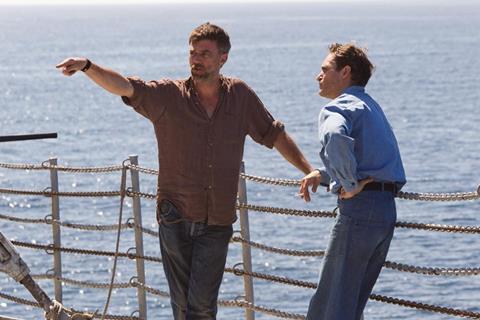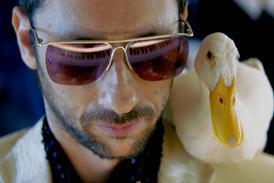Paul Thomas Anderson talks about the inspirations for the film, Joaquin Phoenix’s immersive acting style, shooting large format, and now adapting Thomas Pynchon’s Inherent Vice.

Paul Thomas Anderson’s hugely anticipated The Master, starring Joaquin Phoenix and Philip Seymour Hoffman, world-premiered in Venice on Saturday, and now heads to Toronto. Anderson’s first feature since 2007’s Oscar winner There Will Be Blood tells the story of a damaged soldier in post-WWII America who strikes up an unexpected friendship with the charismatic founder of a new religious cult.
Screen spoke to the director during a roundtable interview in Venice immediately after the film’s world premiere.
The Weinstein Company handles international sales and US distribution.
Congratulations on a stunning film. The world was probably expecting something quite different — this is a film about a friendship between two disturbed men.
Thank you. Yes. That was what we talked about all the time. We were concerned with the love story between these two men, about how desperately attracted they are to each other and how good and bad they are for each other. It’s a romance that can never work.
Is it accurate to say your inspirations at script level included unpublished fragments of There Will Be Blood, the lives of John Steinbeck and L. Ron Hubbard and stories from actor Jason Robards?
Yes. Jason Robards told me a story about coming back from the South Pacific after VJ Day on a ship which had run out of booze. The crew broke into the torpedoes to get at the grain alcohol fuel. The soldiers would collect fruit from the islands and mix it with the 180-proof grain fuel to make ‘torpedo juice’. That was quite common.
Robards woke up on the mast of the ship, teetering on the edge, one day. I always wanted to get that into a film.
And yes, John Steinbeck worked the sugar beet fields in California during the prohibition.
It was a process of collecting stories and hoping they found a home with other things. At a certain point, ideally, it starts to write itself. It’s always a chore at first, but then at a point you look back and you can’t believe you’ve written it and it’s a great feeling. But it’s a pain in the ass, to begin with.
Were the two lead male characters the starting point?
I don’t remember. I can’t even say for sure when we were making the film that the love story was the main focus. We pursued different ideas. There were characters in the script who became smaller as we went along. It didn’t have a real map.
But Joaquin and Philip working together was the most exciting thing for me. There weren’t five other stories, it was always about their characters.
Is that the way you usually work?
It’s different each time. This seemed more confused!
What were the greatest challenges? And did you feel the shadow of the Church of Scientology over the project?
Perhaps, yes. We’re living in an age when if someone gets a whiff of what you’re doing it gets speculated about more than anticipated. When you hear that chatter it can get mildly frustrating. But now it seems that people are seeing the film and realising it isn’t about Scientology.
The biggest challenge is getting good material and to have more good days than bad days. It’s a miracle these things get made - it doesn’t get easier. Each film has its own sets of challenges. Scientology was the least of our problems.
Are you still in touch with Tom Cruise?
I am still in touch with Tom Cruise. He did see the film. It’s something between us. Everything is fine, though.
Joaquin went down the method route for this role, spending three months in character?
Yes, the same thing happens with Daniel Day Lewis. He creates the impression that he inhabits someone else 24 hours a day. The reality is that they have to interact with the reality of acting in a movie and that there is an outside world. It would be more accurate to say that his concentration level was incredibly high. There were very few times you didn’t feel like you were around his character. There wasn’t a lot of stepping out of it.
How did you come up with the character’s unusual posture?
He just started standing like that. I thought it was great. It was his idea. He’s incredibly inventive. You never know what he’s going to do. I would say ‘tell me the far left and right of what you might do’. I think it comes from Joaquin spending a lot of his career trying to stand up straight.
Did you conceive The Master in 70mm from the beginning?
Not really. We loved the look of those old VistaVision films like North by Northwest and Vertigo. While it is impractical, when we tested it, it looked and felt great for this story. It kept tumbling forward.
We thought at the time that there wouldn’t be many places to play this in 70mm, but we were pleasantly surprised. There are still a lot of projectors, at least in US, that are 35mm and 70mm combined.
Would you want to shoot your next film using the same format?
It would depend on the story. It would be tempting to do it again. It’s a lovely format. The camera is as big as a table. It’s loud, too. You can hear it in the movie. It’s like a fan at times.
What’s next?
I’m hoping we can get Inherent Vice going soon. That’s what I’m writing now. It’s taking my mind of this, actually. It’s a lot of fun. It’s such a different piece, though. It’s nice to have a collaborator, as it were, through working on the book.
Are you in touch with Thomas Pynchon?
I try to communicate with the book, mainly.






![The Brightest SunScreen[Courtesy HKIFF]](https://d1nslcd7m2225b.cloudfront.net/Pictures/274x183/3/5/0/1448350_thebrightestsunscreencourtesyhkiff_312678.jpg)















No comments yet